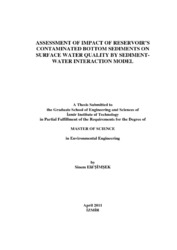Please use this identifier to cite or link to this item:
https://hdl.handle.net/11147/3157Full metadata record
| DC Field | Value | Language |
|---|---|---|
| dc.contributor.advisor | Elçi, Şebnem | - |
| dc.contributor.author | Şimşek, Sinem Elif | - |
| dc.date.accessioned | 2014-07-22T13:51:00Z | - |
| dc.date.available | 2014-07-22T13:51:00Z | - |
| dc.date.issued | 2011 | - |
| dc.identifier.uri | http://hdl.handle.net/11147/3157 | - |
| dc.description | Includes bibliographical references (leaves: 80-82) | en_US |
| dc.description | Text in English; Abstract: Turkish and English | en_US |
| dc.description | xiv, 96 leaves | en_US |
| dc.description | Thesis (Master)--Izmir Institute of Technology, Environmental Engineering, Izmir, 2011 | en_US |
| dc.description.abstract | In this study, an approach for the assessment of the life-long impact of submersed contaminated bottom sediments in projected reservoirs on surface water quality is presented. A sediment-water interaction model designed to simulate contaminants in the sediments and in the overlying water column is developed and the impact of contaminated bottom sediments on water quality is investigated under different scenarios. One goal of this study is to investigate the contribution of contaminated soils underlying the reservoir compared to the contaminants transported by surface and groundwater influx. The proposed study predicts the long term impact of the selected site on water quality before the construction of the dam. The sediment-water interaction model developed in this study consists of three main layers: water column which can be specified as well mixed or stratified according to the temperature profile in the vertical column, a mixed sediment layer and a deep sediments layer. In the model, mass balance equations for contaminants are solved for the water column and the mixed sediment layer.This study further presents the projection of possible contamination in a reservoir based on the analysis of the soil samples collected from the reservoir bottom before the filling of the reservoir. Reverse modeling approach for the prediction of contaminant concentration in the water column originating from the bottom sediments is applied. Transfer of five heavy metals; Copper, Zinc, Chromium, Nickel, and Lead existing in bottom sediments of Çamlı Basin to the reservoir water is modeled. | en_US |
| dc.language.iso | en | en_US |
| dc.publisher | Izmir Institute of Technology | en_US |
| dc.rights | info:eu-repo/semantics/openAccess | en_US |
| dc.subject.lcsh | Water quality--Measurement | en |
| dc.subject.lcsh | Contaminated sediments | en |
| dc.subject.lcsh | Sediment transport--Mathematical models | en |
| dc.title | Assessment of Impact of Reservoir's Contaminated Bottom Sediments on Surfacewater Quality by Sediment-Water Interaction Model | en_US |
| dc.type | Master Thesis | en_US |
| dc.institutionauthor | Şimşek, Sinem Elif | - |
| dc.department | Thesis (Master)--İzmir Institute of Technology, Environmental Engineering | en_US |
| dc.relation.publicationcategory | Tez | en_US |
| dc.identifier.wosquality | N/A | - |
| dc.identifier.scopusquality | N/A | - |
| item.openairecristype | http://purl.org/coar/resource_type/c_18cf | - |
| item.languageiso639-1 | en | - |
| item.openairetype | Master Thesis | - |
| item.grantfulltext | open | - |
| item.fulltext | With Fulltext | - |
| item.cerifentitytype | Publications | - |
| Appears in Collections: | Master Degree / Yüksek Lisans Tezleri Sürdürülebilir Yeşil Kampüs Koleksiyonu / Sustainable Green Campus Collection | |
Files in This Item:
| File | Description | Size | Format | |
|---|---|---|---|---|
| T000961.pdf | MasterThesis | 827.37 kB | Adobe PDF |  View/Open |
CORE Recommender
Page view(s)
280
checked on Mar 31, 2025
Download(s)
100
checked on Mar 31, 2025
Google ScholarTM
Check
Items in GCRIS Repository are protected by copyright, with all rights reserved, unless otherwise indicated.